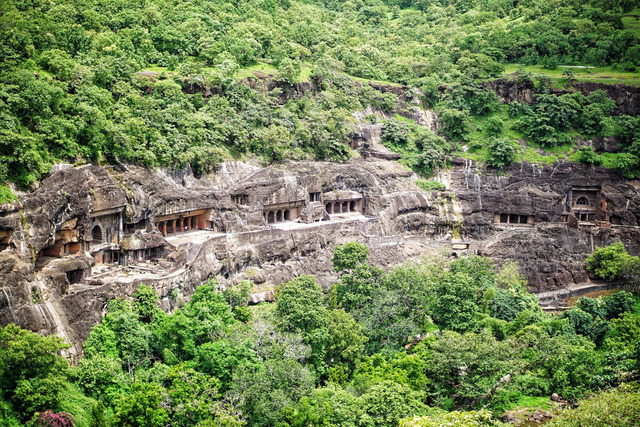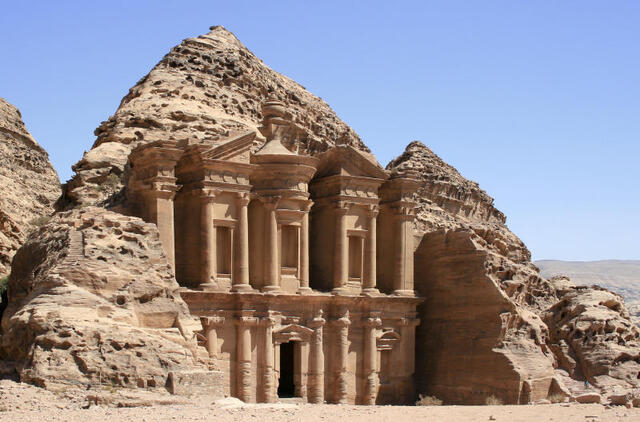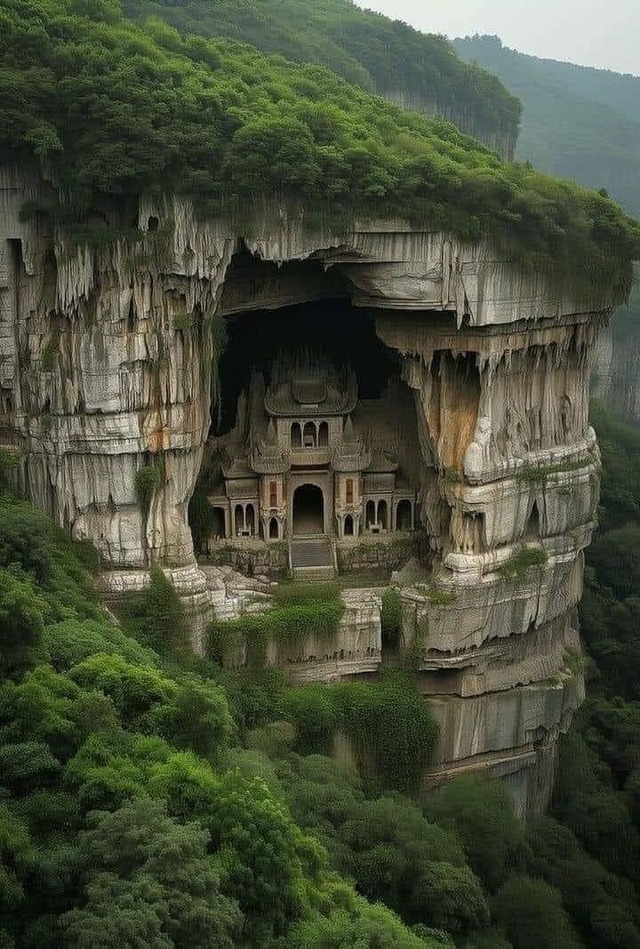Cliffside temples and structures captivate with their ability to blend human craftsmanship with nature’s grandeur. The temple in the image above, though a product of digital artistry, evokes the timeless allure of such architectural wonders. In this article, we’ll explore real-world temples and sanctuaries carved into cliffs that share the same breathtaking beauty and cultural significance.
The Featured Temple: A Sanctuary in the Cliff
The temple depicted in the image is not a real structure but a stunning example of AI-generated artistry. Its design draws inspiration from the architectural ingenuity of cliffside temples found worldwide. The intricate carvings, harmonious integration with the surrounding rock, and lush greenery evoke a sense of serenity and awe.
While this specific image is fictional, it serves as a gateway to discovering real-life cliffside structures that have stood for centuries. These masterpieces, steeped in history and spiritual significance, showcase how ancient builders brought visions like this to life. In the sections that follow, we’ll delve into some of the world’s most iconic and awe-inspiring cliffside sanctuaries.
Historical and Cultural Significance of Cliffside Temples
Cliffside temples have been an integral part of many ancient civilizations, symbolizing spiritual elevation and protection. Perched high above ground, these structures often represented the connection between earth and sky, creating a tranquil space for meditation and worship. The choice to embed such sanctuaries into cliffs was not only symbolic but also practical. Cliffs provided natural defense from invaders and isolation from the distractions of daily life, making them ideal for religious or monastic communities.
Beyond their practical benefits, these temples also hold cultural significance. Many were adorned with carvings and paintings that depicted religious stories, myths, or historical events, serving as both places of worship and repositories of cultural knowledge. For example, Buddhist monks in India used cliffside caves not only as retreats but also as spaces to teach and preserve sacred texts through elaborate murals and carvings.
Iconic Cliffside Temples and Structures Around the World
Hanging Monastery (China)

Located in Shanxi province, the Hanging Monastery is an awe-inspiring temple complex suspended on a sheer cliff face. Built over 1,500 years ago, this marvel combines elements of Taoism, Buddhism, and Confucianism. Its wooden beams are ingeniously embedded into the cliff, creating the illusion of defying gravity. The monastery’s precarious position and intricate architecture make it a testament to ancient Chinese engineering.
Video:
Ajanta Caves (India)

Dating back to the 2nd century BCE, the Ajanta Caves in Maharashtra are a series of rock-cut Buddhist temples carved into a horseshoe-shaped cliff. These caves feature exquisite sculptures and frescoes that depict the life of Buddha and scenes from Jataka tales. The intricate artistry and serene atmosphere make the Ajanta Caves one of India’s most treasured historical sites.
Video:
Petra (Jordan)

Known as the “Rose City,” Petra is a UNESCO World Heritage Site famous for its rock-cut architecture. The Nabateans carved temples, tombs, and theaters directly into the sandstone cliffs over 2,000 years ago. Among its most iconic structures is the Treasury, a stunning façade that combines Hellenistic and Middle Eastern architectural styles. Petra’s blend of natural beauty and human craftsmanship continues to captivate visitors from around the world.
Video:
Sumela Monastery (Turkey)

Perched on the side of a steep cliff in the Pontic Mountains, the Sumela Monastery is a Greek Orthodox monastery dating back to the 4th century. Its remote location offered seclusion and protection, while its frescoed interiors reflect the religious devotion of its creators. The monastery’s dramatic setting amidst lush forests and rugged mountains enhances its spiritual significance.
Video:
Monasteries of Meteora (Greece)
The Meteora monasteries are a group of six monastic complexes built atop towering rock formations in central Greece. Originally accessible only by rope ladders or baskets, these monasteries provided monks with solitude and safety. Their elevated position not only symbolizes spiritual ascension but also offers breathtaking panoramic views of the surrounding landscape.
Video:
Architectural Techniques in Cliffside Construction
Building temples and structures into cliffs required extraordinary skill and innovation. Ancient architects had to overcome significant challenges, including stabilizing structures on vertical surfaces and carving intricate details into solid rock. The tools and techniques used in cliffside construction demonstrate a profound understanding of engineering and materials.
In many cases, natural formations were utilized to enhance the design. For example, caves and ledges provided ready-made spaces that could be expanded or sculpted into elaborate temples. Builders often used wooden scaffolding to reach higher points and employed rudimentary chisels and hammers to carve intricate details. In Petra, the sandstone’s relative softness allowed for detailed carving, while its durability ensured the longevity of the structures.
These techniques highlight the ingenuity and perseverance of ancient builders who created architectural masterpieces that continue to inspire awe.

The Spiritual Connection Between Architecture and Nature
One of the most compelling aspects of cliffside temples is their deep connection to nature. By integrating architecture with natural landscapes, these structures symbolize harmony between humanity and the environment. The secluded settings of these temples often create an atmosphere of peace and introspection, making them ideal spaces for meditation and worship.
Cultural practices in these spaces further emphasize their spiritual significance. Rituals and ceremonies conducted in cliffside temples often incorporate elements of nature, such as water from nearby springs, light filtering through crevices, or the echoing sound of chants within rock chambers. These practices reinforce the idea that spiritual enlightenment can be found in harmony with the natural world.
Conclusion
Cliffside temples are a testament to humanity’s ingenuity and deep connection to nature. While the temple in the image above is a work of imagination, real-world examples like the Hanging Monastery and Petra invite us to explore their breathtaking beauty and historical significance. By visiting or learning about these marvels, we continue to celebrate the enduring legacy of architectural harmony and spiritual aspiration.
